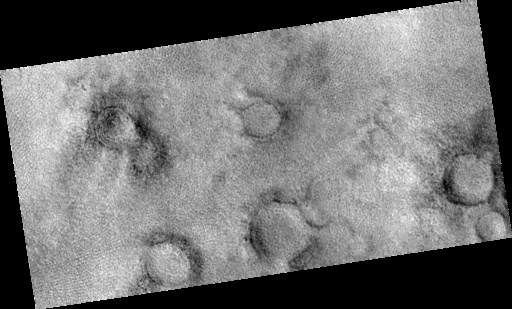Polygonal Terrain in the Northern Plains
 HiRISE Product ID: TRA_000828_2495_IRB
This color image covers only the center swath of
the full image, and is composed of images acquired through infrared, red,
and blue-green filters. The color has been enhanced to better show the
subtle color differences. It is not natural color or how it would appear
to normal human vision.
HiRISE Product ID: TRA_000828_2495_IRB
This color image covers only the center swath of
the full image, and is composed of images acquired through infrared, red,
and blue-green filters. The color has been enhanced to better show the
subtle color differences. It is not natural color or how it would appear
to normal human vision.
A network of shallow surface troughs and fissures coalesce into polygonal patterns that are ubiquitous throughout this image. Polygonal patterned ground of this nature is quite common in permafrost regions of Earth, where seasonal thermal contraction of ice-cemented soil produces a honeycomb network of subsurface cracks. Cracks of this nature can also be produced by desiccation (mud cracks) or lava cooling (columnar joints), though typically on a smaller scale. The diameter of these martian polygons are dominantly 10-20 meters, analogous to terrestrial permafrost. The individual troughs are frequently only a couple of meters or less wide, and easily resolved at HiRISE resolution. Other characteristics, such as small ridges on either side of the troughs and the distribution of rocks in and around each polygon is also readily apparent. Small rocks and occasional larger boulders are also seen scattered throughout the image. Rocks protruding above the surface soil can be seen to cast shadows (solar illumination is from the lower left), which can aid in the determination of the rock's size and height. This image is located near an area under consideration as a landing site for the Mars Scout mission, Phoenix, planned for 2008. Examination of many factors including surface texture (roughness and morphology) and the size distribution of rocks will aid in final landing site selection.
Image TRA_000828_2495 was taken by the High Resolution Imaging Science Experiment (HiRISE) camera onboard the Mars Reconnaissance Orbiter spacecraft on Sunday, 01 October 2006. The complete image is centered at 69.1 degrees latitude, 130.3 degrees East longitude. The range to the target site was 315.4 km (197.1 miles). At this distance the image scale is 31.6 cm/pixel (with 1 x 1 binning) so objects ~95 cm across are resolved. The image shown here [below] has been map-projected to 25 cm/pixel. The image was taken at a local Mars time of 3:01 PM and the scene is illuminated from the west with a solar incidence angle of 53 degrees, thus the sun was about 37 degrees above the horizon. At a solar longitude of 113.7 degrees, the season on Mars is Northern Summer.
 HiRISE Product ID: TRA_000828_2495_RED
HiRISE Product ID: TRA_000828_2495_RED
Images from the High Resolution Imaging Science Experiment and additional information about the Mars Reconnaissance Orbiter are available online at:
http://www.nasa.gov/mro
or
http://HiRISE.lpl.arizona.edu.
For information about NASA and agency programs on the Web, visit: http://www.nasa.gov. NASA's Jet Propulsion Laboratory, a division of the California Institute of Technology in Pasadena, manages the Mars Reconnaissance Orbiter for NASA's Science Mission Directorate, Washington. Lockheed Martin Space Systems is the prime contractor for the project and built the spacecraft. The HiRISE camera was built by Ball Aerospace and Technology Corporation and is operated by the University of Arizona.
